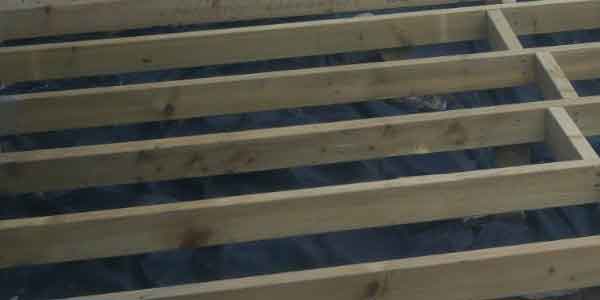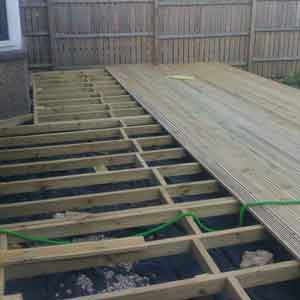Most large timbers used in construction, such as floor joists are kiln dried graded products. This means they are high quality timbers, and the higher the grade, the fewer visible defects the timber will have.
For example, a higher graded timber will have less large visible knots and the wood will generally be straighter and free from bows, warps, cups, cracks, shakes and any other visible defects.
Another option that can increase the quality of the product is pressure treatment.
Floor joists can be purchased either treated or untreated. The type you choose will depend on where it is being installed. For example, if joists are at a higher risk of moisture, then a pressure treated timber is usually a better option.
Using a pressure treated timber, will protect against wood rot, and wood burrowing insects that feed on timber.

Best reason to choose treated floor joists
In many modern construction projects, treated timber is the standard timber used for new floor joists unless something like i joists are being used. This is mainly due to the fact, that the difference in price is only marginal and treated timbers are a superior product.
For example, at my local timber merchant, the price today for a 3.8m joist @ 45mm x 195mm (2×8 inch) is:
Treated = £19.54
Untreated = £18.18
So, as you can see, this is only £1.36 more per joist if you choose treated. Even over the entire floor of a property, the difference isn’t that much, and it gives far better protection over time, compared with a standard untreated timber.
With that said, pressure treating of timber was only introduced in the 1960’s. Therefore, if your joists were installed before this time, they are definitely untreated, and the majority have probably stood the test of time.
So, an untreated joist can certainly be suitable in most areas of your home. It just boils down to whether you want to spend an extra £1, or £2 and opt for a better-quality product.
Areas where you should opt for treated floor joists
There are certain times when you should definitely choose a treated timber. Some of the main examples include:
- Adding new joists at ground floor level. This is an area that is susceptible to damp and rot. Timber at this level can become damp due to water rising from the ground. This is known as rising damp and is usually the result of a faulty or missing damp proof course. This type of moisture can generally rise as high as 1m above ground level.
- Replacing rotten timbers housed into the internal brickwork. This is again very common and is caused by damp. As the ends of the joists become wet over time, wood rot takes hold and the wood deteriorates.
- Timber wall plates. This is not always essential. However, because the timber is in constant contact with the wall, it is at a higher risk of absorbing moisture and becoming rotten.
- Anywhere that is being replaced as a result of rot. If you found rot, then it makes sense to replace any affected joists with a treated timber. You should also try to clean the area thoroughly, to remove any rot spores, and consider treating the surrounding timbers.
- After woodworm or termite infestation. Depending on where you are in the world, different types of wood burrowing insects could be an issue. In America this would often be termites, for the UK and Europe, various species of woodworm would be more common. Either way, a pressure treated timber would provide protection against future infestation. The insects will not consume the wood when it contains chemicals from the wood treatment.
- Anywhere outside. Obviously, if you are installing joists outside, for example building a deck, then treated timbers are pretty much essential. The image below shows a deck I built in my back garden and all the joists were pressure treated.

Conclusion and my personal opinion
As you can see, floor joist can be purchased in both treated and untreated forms
There are several reasons you would choose treated joists over untreated. However, it is still worth pointing out, that the majority of joists installed throughout the country, and definitely those before the 60’s are not treated, and most are still holding up pretty good.
With that said, the price difference between treated and untreated is so small, that I can’t think of a situation, where I would choose untreated if I had the choice.
A treated timber is just a better product, and it will last far longer.
Not only that, but you almost entirely remove the risk of insect infestation. This alone could ravage the timber in a property if let loose on nice, tasty, untreated timbers.




